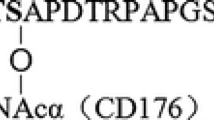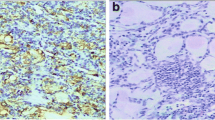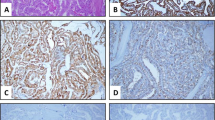Abstract
Purpose
Elevated serum levels of carbohydrate antigen 19.9 (CA19.9), a well-established tumor marker in pancreatic neoplasms, has been proposed as a prognostic marker of tumor aggressiveness in medullary thyroid carcinoma (MTC). A hypothesis of C-cell dedifferentiation has been raised. Here, we evaluated the expression of CA19.9 and CD133, a stem cell marker, in MTC tissues.
Methods
MTC samples from patients attending a university-based hospital were evaluated for CA19.9 and CD133 expression by immunohistochemistry. Clinical data were retrieved from medical records.
Results
Tumor specimens from 70 MTC patients (57.1% hereditary) were evaluated. The age at diagnosis was 36.1 ± 16.3 years, and 58.6% were female; 53% of patients had cervical and 20% distant metastases. CA19.9 staining was detected in 87% of the samples, but no association was observed with biochemical markers, tumor size, local or distant metastases (All P > 0.05). Remarkable, CA19.9 expression was higher in the metastasis than in primary tumor samples (P = 0.0002). CD133 was expressed in 90.5% samples, but no correlation was found with CA19.9. Interestingly, we identified three distinct expression patterns to CA19.9: individual, focal, and diffuse cells. Sporadic MTC was associated with the individual cell pattern (70.6%), while the hereditary form with the focal expression pattern (63.9%; P = 0.04). Remarkably, the diffuse pattern was associated with larger tumor size and distant metastases (P = 0.032).
Conclusions
The majority of samples stained for CA19.9, suggesting it is an MTC cell-intrinsic feature. Three distinct expression patterns were identified, which were associated with the hereditary or sporadic form, larger tumor size, and presence of metastases.



Similar content being viewed by others
References
L. Davies, H.G. Welch, Increasing incidence of thyroid cancer in the United States, 1973-2002. JAMA 295(18), 2164–2167 (2006). https://doi.org/10.1001/jama.295.18.2164
S.A. Hundahl, I.D. Fleming, A.M. Fremgen, H.R. Menck, A National Cancer Data Base report on 53,856 cases of thyroid carcinoma treated in the U.S., 1985-1995 [see commetns]. Cancer 83(12), 2638–2648 (1998). 10.1002/(SICI)1097-0142(19981215)83:12<2638::AID-CNCR31>3.0.CO;2-1 [pii]
M.R. Pelizzo, I.M. Boschin, P. Bernante, A. Toniato, A. Piotto, C. Pagetta, O. Nibale, L. Rampin, P.C. Muzzio, D. Rubello, Natural history, diagnosis, treatment and outcome of medullary thyroid cancer: 37 years experience on 157 patients. Eur. J. Surg. Oncol. 33(4), 493–497 (2007). https://doi.org/10.1016/j.ejso.2006.10.021
A.L. Maia, S.M. Wajner, C.V. Vargas, Advances and controversies in the management of medullary thyroid carcinoma. Curr. Opin. Oncol. 29(1), 25–32 (2017). https://doi.org/10.1097/CCO.0000000000000340
A. Laure Giraudet, A. Al Ghulzan, A. Auperin, S. Leboulleux, A. Chehboun, F. Troalen, C. Dromain, J. Lumbroso, E. Baudin, M. Schlumberger, Progression of medullary thyroid carcinoma: assessment with calcitonin and carcinoembryonic antigen doubling times. Eur. J. Endocrinol. 158(2), 239–246 (2008). https://doi.org/10.1530/EJE-07-0667
J.A. Meijer, S. le Cessie, W.B. van den Hout, J. Kievit, J.W. Schoones, J.A. Romijn, J.W. Smit, Calcitonin and carcinoembryonic antigen doubling times as prognostic factors in medullary thyroid carcinoma: a structured meta-analysis. Clin. Endocrinol. 72(4), 534–542 (2010). https://doi.org/10.1111/j.1365-2265.2009.03666.x
J. Barbet, L. Campion, F. Kraeber-Bodere, J.F. Chatal, Prognostic impact of serum calcitonin and carcinoembryonic antigen doubling-times in patients with medullary thyroid carcinoma. J. Clin. Endocrinol. Metab. 90(11), 6077–6084 (2005). https://doi.org/10.1210/jc.2005-0044
R. Lamerz, Role of tumour markers, cytogenetics. Ann. Oncol. 10(Suppl 4), 145–149 (1999).
V. Hess, B. Glimelius, P. Grawe, D. Dietrich, G. Bodoky, T. Ruhstaller, E. Bajetta, P. Saletti, A. Figer, W. Scheithauer, R. Herrmann, CA 19-9 tumour-marker response to chemotherapy in patients with advanced pancreatic cancer enrolled in a randomised controlled trial. Lancet Oncol. 9(2), 132–138 (2008). https://doi.org/10.1016/S1470-2045(08)70001-9
N.R. Maisey, A.R. Norman, A. Hill, A. Massey, J. Oates, D. Cunningham, CA19-9 as a prognostic factor in inoperable pancreatic cancer: the implication for clinical trials. Br. J. Cancer 93(7), 740–743 (2005). https://doi.org/10.1038/sj.bjc.6602760
O. Micke, F. Bruns, R. Kurowski, E. Horst, A.F. deVries, J.W. Hausler, N. Willich, U. Schafer, Predictive value of carbohydrate antigen 19-9 in pancreatic cancer treated with radiochemotherapy. Int J. Radiat. Oncol. Biol. Phys. 57(1), 90–97 (2003). S0360301603005248 [pii]
R. Passerini, M.C. Cassatella, S. Boveri, M. Salvatici, D. Radice, L. Zorzino, C. Galli, M.T. Sandri, The pitfalls of CA19-9: routine testing and comparison of two automated immunoassays in a reference oncology center. Am. J. Clin. Pathol. 138(2), 281–287 (2012). https://doi.org/10.1309/AJCPOPNPLLCYR07H
R. Elisei, L. Lorusso, C. Romei, V. Bottici, S. Mazzeo, C. Giani, E. Fiore, L. Torregrossa, A.C. Insilla, F. Basolo, A. Guerini, A. Menghi, A. Poletti, L. Cugudda, P. Vitti, Medullary thyroid cancer secreting carbohydrate antigen 19-9 (Ca 19-9): a fatal case report. J. Clin. Endocrinol. Metab. 98(9), 3550–3554 (2013). https://doi.org/10.1210/jc.2013-1940
S. Milman, K.D. Whitney, N. Fleischer, Metastatic medullary thyroid cancer presenting with elevated levels of CA 19-9 and CA 125. Thyroid 21(8), 913–916 (2011). https://doi.org/10.1089/thy.2010.0425
R. Elisei, L. Lorusso, P. Piaggi, L. Torregrossa, G. Pellegrini, E. Molinaro, L. Agate, V. Bottici, F. Pani, A. Cacciato Insilla, F. Casella, R. Ciampi, I. Tognetti, G. Materazzi, F. Basolo, C. Romei, Elevated level of serum carbohydrate antigen 19.9 as predictor of mortality in patients with advanced medullary thyroid cancer. Eur. J. Endocrinol. 173(3), 297–304 (2015). https://doi.org/10.1530/EJE-15-0304
R. Alencar, D.B. Kendler, F. Andrade, C. Nava, D. Bulzico, C.C.D. Pessoa, R. Corbo, F. Vaisman, CA19-9 as a Predictor of Worse Clinical Outcome in Medullary Thyroid Carcinoma. Eur. Thyroid J. 8(4), 186–191 (2019). https://doi.org/10.1159/000497201
D.R. Siqueira, M. Romitti, A.P. da Rocha, L. Ceolin, C. Meotti, A. Estivalet, M.K. Punales, A.L. Maia, The RET polymorphic allele S836S is associated with early metastatic disease in patients with hereditary or sporadic medullary thyroid carcinoma. Endocr. Relat. Cancer 17(4), 953–963 (2010). https://doi.org/10.1677/ERC-09-0312
S.A. Wells Jr., S.L. Asa, H. Dralle, R. Elisei, D.B. Evans, R.F. Gagel, N. Lee, A. Machens, J.F. Moley, F. Pacini, F. Raue, K. Frank-Raue, B. Robinson, M.S. Rosenthal, M. Santoro, M. Schlumberger, M. Shah, S.G. Waguespack, Revised American Thyroid Association guidelines for the management of medullary thyroid carcinoma. Thyroid 25(6), 567–610 (2015). https://doi.org/10.1089/thy.2014.0335
M.B. Amin, S. Edge, F. Greene, D.R. Byrd, R.K. Brookland, M.K. Washington, J.E. Gershenwald, C.C. Compton, K.R. Hess, D.C. Sullivan, J.M. Jessup, J.D. Brierley, L.E. Gaspar, R.L. Schilsky, C.M. Balch, D.P. Winchester, E.A. Asare, M. Madera, D.M. Gress, L.R. Meyer (Eds.), AJCC Cancer Staging Manual (8th edition) (Springer International Publishing, American Joint Commission on Cancer, 2017)
A.L. Maia, D.R. Siqueira, M.A. Kulcsar, A.J. Tincani, G.M. Mazeto, L.M. Maciel, Diagnosis, treatment, and follow-up of medullary thyroid carcinoma: recommendations by the Thyroid Department of the Brazilian Society of Endocrinology and Metabolism. Arq. Bras. Endocrinol. Metab. 58(7), 667–700 (2014)
S. Milman, J.L. Arnold, M. Price, A. Negassa, M.I. Surks, N. Fleischer, K.D. Whitney, Medullary thyroid cancer that stains negative for Ca 19-9 has decreased metastatic potential. Endocr. Pr. 21(6), 590–594 (2015). https://doi.org/10.4158/EP14357.OR
W. Zhu, T. Hai, L. Ye, G.J. Cote, Medullary thyroid carcinoma cell lines contain a self-renewing CD133+ population that is dependent on ret proto-oncogene activity. J. Clin. Endocrinol. Metab. 95(1), 439–444 (2010). https://doi.org/10.1210/jc.2009-1485
Y. Bi, Y. Meng, H. Wu, Q. Cui, Y. Luo, X. Xue, Expression of the potential cancer stem cell markers CD133 and CD44 in medullary thyroid carcinoma: A ten-year follow-up and prognostic analysis. J. Surg. Oncol. 113(2), 144–151 (2016). https://doi.org/10.1002/jso.24124
Funding
This work has been made possible by grants from Conselho Nacional de Desenvolvimento Científico e Tecnológico (CNPq), Coordenação de Aperfeiçoamento de Pessoal de Nível Superior (CAPES), Fundo de Incentivo a Pesquisa (FIPE), and Programa de Apoio a Núcleos de Excelência (PRONEX)/Fundação de Amparo à Pesquisa do Estado do Rio Grande do Sul (FAPERGS).
Author information
Authors and Affiliations
Contributions
Conception and design: C.V.F.V., A.L.M. Provision of study materials or patients: A.L.M. Collection and assembly of data: all authors. Data analysis and interpretation: C.V.F.V., L.C., R.S.S., A.L.M. Manuscript writing: C.V.F., L.C., R.S.S., and A.L.M. Final approval of manuscript: all authors.
Corresponding author
Ethics declarations
Conflict of interest
The authors declare that they have no conflict of interest.
Ethical approval
All procedures performed in studies involving human participants were in accordance with the ethical standards of the institutional and/or national research committee and with the 1964 Helsinki declaration and its later amendments or comparable ethical standards.
Informed consent
All patients or their legal guardians provided written informed consent by following the institutional Ethics Committee (CAAE 62017016300005327).
Additional information
Publisher’s note Springer Nature remains neutral with regard to jurisdictional claims in published maps and institutional affiliations.
Rights and permissions
About this article
Cite this article
Vargas, C.V.F., Ceolin, L., Scheffel, R.S. et al. The tissue expression pattern of CA 19.9 is associated with oncological features in medullary thyroid carcinoma. Endocrine 70, 544–551 (2020). https://doi.org/10.1007/s12020-020-02377-3
Received:
Accepted:
Published:
Issue Date:
DOI: https://doi.org/10.1007/s12020-020-02377-3




